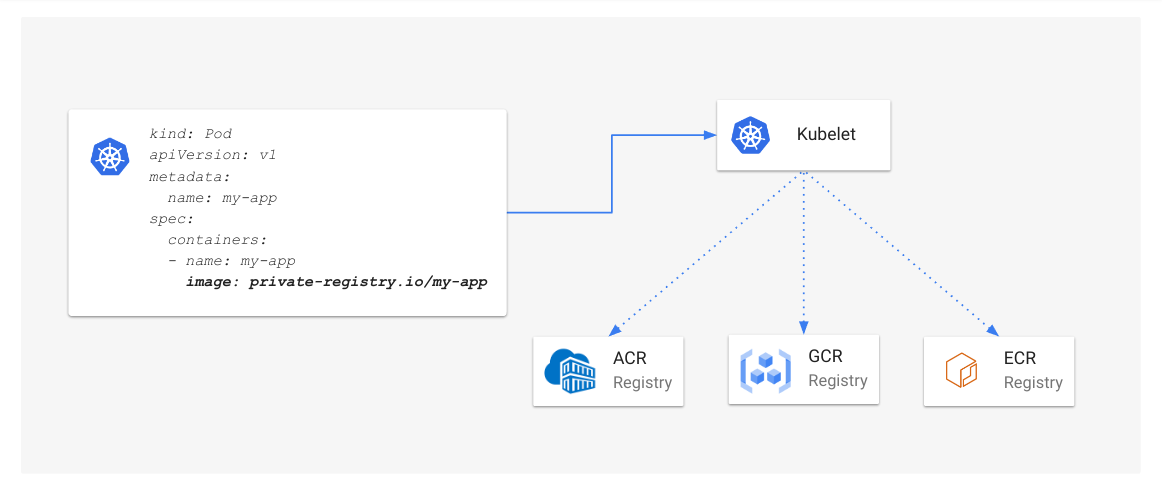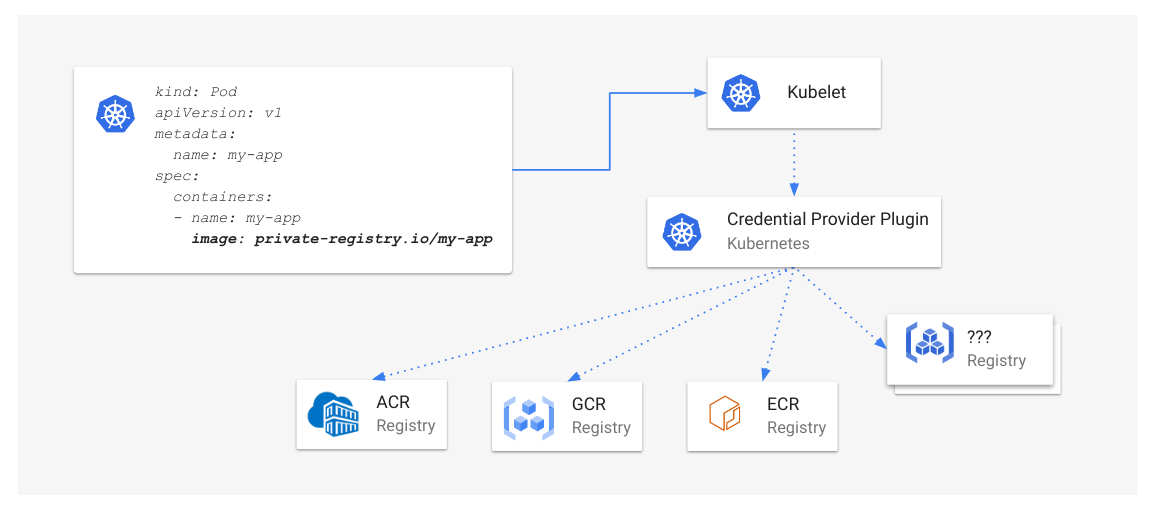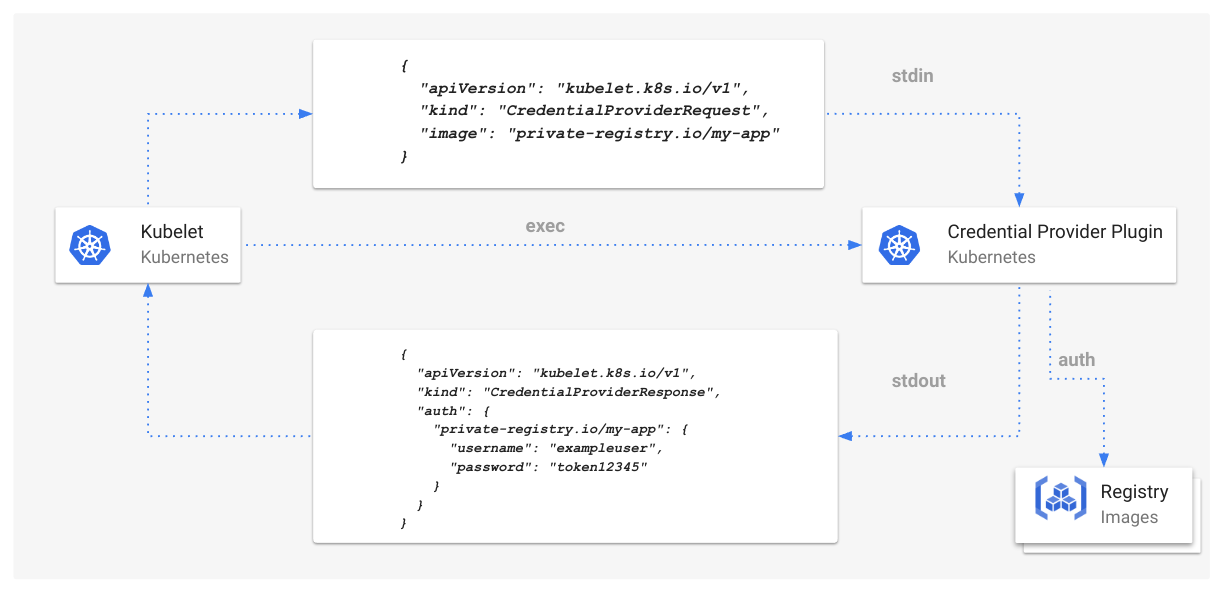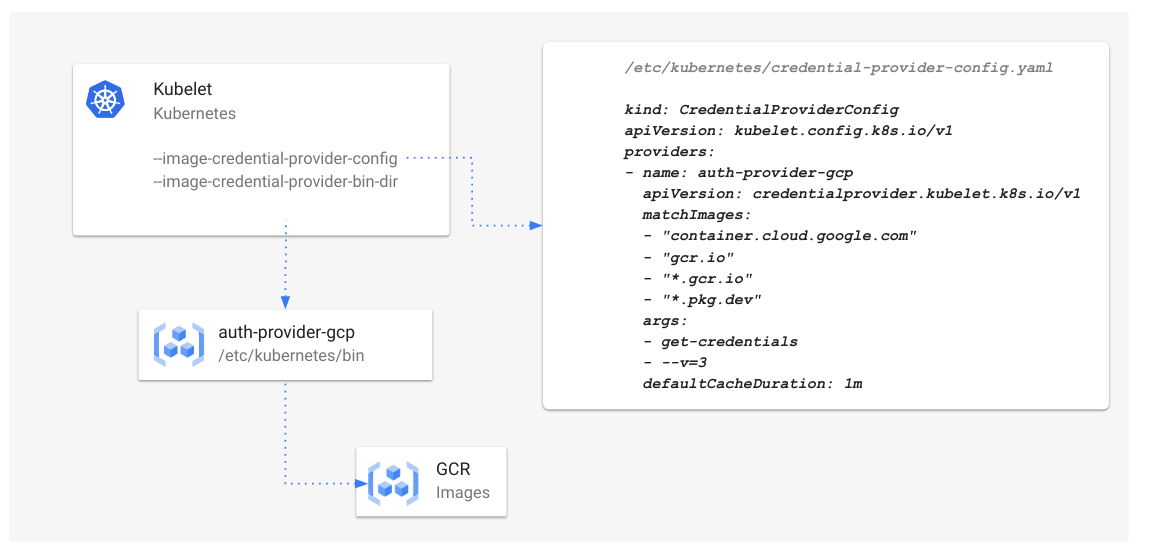This article is more than one year old. Older articles may contain outdated content. Check that the information in the page has not become incorrect since its publication.
Kubernetes v1.26: GA Support for Kubelet Credential Providers
Kubernetes v1.26 introduced generally available (GA) support for kubelet credential provider plugins, offering an extensible plugin framework to dynamically fetch credentials for any container image registry.
Background
Kubernetes supports the ability to dynamically fetch credentials for a container registry service. Prior to Kubernetes v1.20, this capability was compiled into the kubelet and only available for Amazon Elastic Container Registry, Azure Container Registry, and Google Cloud Container Registry.

Figure 1: Kubelet built-in credential provider support for Amazon Elastic Container Registry, Azure Container Registry, and Google Cloud Container Registry.
Kubernetes v1.20 introduced alpha support for kubelet credential providers plugins, which provides a mechanism for the kubelet to dynamically authenticate and pull images for arbitrary container registries - whether these are public registries, managed services, or even a self-hosted registry. In Kubernetes v1.26, this feature is now GA

Figure 2: Kubelet credential provider overview
Why is it important?
Prior to Kubernetes v1.20, if you wanted to dynamically fetch credentials for image registries other than ACR (Azure Container Registry), ECR (Elastic Container Registry), or GCR (Google Container Registry), you needed to modify the kubelet code. The new plugin mechanism can be used in any cluster, and lets you authenticate to new registries without any changes to Kubernetes itself. Any cloud provider or vendor can publish a plugin that lets you authenticate with their image registry.
How it works
The kubelet and the exec plugin binary communicate through stdio (stdin, stdout, and stderr) by sending and receiving
json-serialized api-versioned types. If the exec plugin is enabled and the kubelet requires authentication information for an image
that matches against a plugin, the kubelet will execute the plugin binary, passing the CredentialProviderRequest API via stdin. Then
the exec plugin communicates with the container registry to dynamically fetch the credentials and returns the credentials in an
encoded response of the CredentialProviderResponse API to the kubelet via stdout.

Figure 3: Kubelet credential provider plugin flow
On receiving credentials from the kubelet, the plugin can also indicate how long credentials can be cached for, to prevent unnecessary execution of the plugin by the kubelet for subsequent image pull requests to the same registry. In cases where the cache duration is not specified by the plugin, a default cache duration can be specified by the kubelet (more details below).
{
"apiVersion": "kubelet.k8s.io/v1",
"kind": "CredentialProviderResponse",
"auth": {
"cacheDuration": "6h",
"private-registry.io/my-app": {
"username": "exampleuser",
"password": "token12345"
}
}
}
In addition, the plugin can specify the scope in which cached credentials are valid for. This is specified through the cacheKeyType field
in CredentialProviderResponse. When the value is Image, the kubelet will only use cached credentials for future image pulls that exactly
match the image of the first request. When the value is Registry, the kubelet will use cached credentials for any subsequent image pulls
destined for the same registry host but using different paths (for example, gcr.io/foo/bar and gcr.io/bar/foo refer to different images
from the same registry). Lastly, when the value is Global, the kubelet will use returned credentials for all images that match against
the plugin, including images that can map to different registry hosts (for example, gcr.io vs registry.k8s.io (previously k8s.gcr.io)). The cacheKeyType field is required by plugin
implementations.
{
"apiVersion": "kubelet.k8s.io/v1",
"kind": "CredentialProviderResponse",
"auth": {
"cacheKeyType": "Registry",
"private-registry.io/my-app": {
"username": "exampleuser",
"password": "token12345"
}
}
}
Using kubelet credential providers
You can configure credential providers by installing the exec plugin(s) into a local directory accessible by the kubelet on every node. Then you set two command line arguments for the kubelet:
--image-credential-provider-config: the path to the credential provider plugin config file.--image-credential-provider-bin-dir: the path to the directory where credential provider plugin binaries are located.
The configuration file passed into --image-credential-provider-config is read by the kubelet to determine which exec plugins should be invoked for a container image used by a Pod.
Note that the name of each provider must match the name of the binary located in the local directory specified in --image-credential-provider-bin-dir, otherwise the kubelet
cannot locate the path of the plugin to invoke.
kind: CredentialProviderConfig
apiVersion: kubelet.config.k8s.io/v1
providers:
- name: auth-provider-gcp
apiVersion: credentialprovider.kubelet.k8s.io/v1
matchImages:
- "container.cloud.google.com"
- "gcr.io"
- "*.gcr.io"
- "*.pkg.dev"
args:
- get-credentials
- --v=3
defaultCacheDuration: 1m
Below is an overview of how the Kubernetes project is using kubelet credential providers for end-to-end testing.

Figure 4: Kubelet credential provider configuration used for Kubernetes e2e testing
For more configuration details, see Kubelet Credential Providers.
Getting Involved
Come join SIG Node if you want to report bugs or have feature requests for the Kubelet Credential Provider. You can reach us through the following ways: